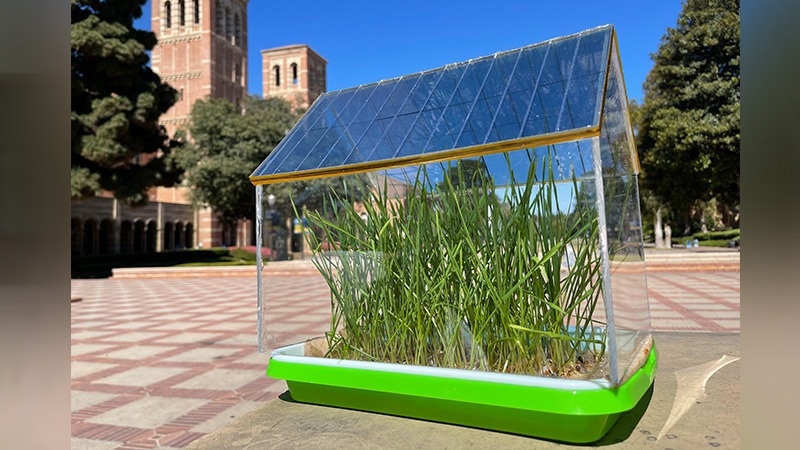Renewable energy sources like solar panels are in great demand as countries around the world search for sustainable energy sources and the United States aspires to become a net-zero emissions economy by 2050.
 A miniature greenhouse prototype with its roof built of semi-transparent solar cells invented by UCLA materials scientists that resulted in better plant growth than a traditional greenhouse. Image Credit: Yang Yang Laboratory/UCLA.
A miniature greenhouse prototype with its roof built of semi-transparent solar cells invented by UCLA materials scientists that resulted in better plant growth than a traditional greenhouse. Image Credit: Yang Yang Laboratory/UCLA.
Solar panels, on the other hand, can take up a lot of space and are often hard to scale. Enter the new field of agrivoltaics, which concentrates on using land for both solar power generation and agriculture at the same time. For instance, substituting the glass in greenhouses with solar panels could power the greenhouse's lamps and water controls, or even the entire farm.
But how does one construct solar panels that can absorb solar energy without obstructing the light that plants require?
Yang Yang, a materials scientist at UCLA’s Samueli School of Engineering, and his colleagues have created a tool that meets these demands. They investigated a new, viable application of solar cells that do not demand large plots of land in a study published in Nature Sustainability.
The group has devised a method for improving semi-transparent organic solar cells. Carbon-based materials are used in these cells, as opposed to inorganic substances in traditional devices. The researchers added a layer of a naturally existing chemical called L-glutathione, which is sold over the counter as an antioxidant dietary supplement. They discovered that the addition lengthened the lifetime of the solar cells, enhanced their efficiency, and still enabled adequate sunlight to reach plants in a greenhouse prototype about the size of a small dollhouse.
Organic materials are uniquely suitable for agrivoltaics because of their light-absorption selectivity. The main drawback that has prevented their widespread use up to now is their lack of stability.
Yang Yang, Materials Scientist, Samueli School of Engineering, University of California, Los Angeles
Yang also has a faculty appointment in bioengineering and holds UCLA’s Carol and Lawrence E. Tannas Jr. Chair in Engineering.
Organic solar cells deteriorate faster than inorganic solar cells since sunlight can end up causing organic materials to oxidize and thus lose electrons. The scientists discovered that the additional layer of L-glutathione kept the other materials in the solar cell from oxidizing, resulting in organic cells with more than 80% efficiency after 1,000 hours of continuous use—compared to less than 20% without the added layer.
In two separate demonstrations, the investigators also monitored the growth of common crops such as wheat, mung beans, and broccoli. One had a transparent glass roof with inorganic solar cell segments, while the other had a roof exclusively made of semi-transparent organic solar cells.
Crops in the organic solar roof greenhouse grew faster than crops in a usual greenhouse. The researchers believe this is because the L-glutathione layer obstructed ultraviolet rays, which can hinder plant growth, as well as infrared rays, which can overheat greenhouses and cause plants inside to demand more water.
We didn’t expect the organic solar cells to outperform a conventional glass-roof greenhouse. But we repeated the experiments multiple times with the same results and after further research and analysis, we discovered that plants don’t need as much sunlight to grow as we’d originally thought. In fact, too much sun exposure can do more harm than good, especially in climates such as California’s, where sunlight is more abundant.
Yepin Zhao, Study Lead Author and Postdoctoral Scholar, University of California, Los Angeles
Yepin Zhao is a Postdoctoral Scholar in Yang’s laboratory.
Following these observations, the group created a startup at UCLA with the goal of scaling up the production of organic solar cells for industrial use. The researchers suggested that they hope to commercialize environmentally friendly greenhouses that incorporate organic solar cells in the future.
The study involved researchers from UCLA Samueli’s Materials Science and Engineering Department: Zongqi Li, Dong Meng, Wenxin Yang, Xinyao Wang, Qiyu Xing, Bin Chang, Yifan Zhou, Elizabeth Zhang, Ran Zheng, Kung-Hwa Wei and Elizabeth G. Scott, who is also affiliated with Columbia University.
Ken Houk, a UCLA Chemistry and Biochemistry professor; Ilhan Yavuz of Marmara University in Turkey; Caner Deger, who is affiliated with UCLA and Marmara University; Miroslav Peric of California State University, Northridge; as well as Minhuan Wang, Yanfeng Yin, Jiming Bian and Yantao Shi from the Dalian University of Technology in China are also associated with the research.
The study was funded by the California Energy Commission, with additional support from the National Center for High Performance Computing of Turkey. Individual authors also received funds from the National Natural Science Foundation of China, the China Postdoctoral Science Foundation, and the US National Science Foundation.
Journal Reference:
Zhao, Y., et al. (2023) Achieving sustainability of greenhouses by integrating stable semi-transparent organic photovoltaics. Nature Sustainability. doi.org/10.1038/s41893-023-01071-2.